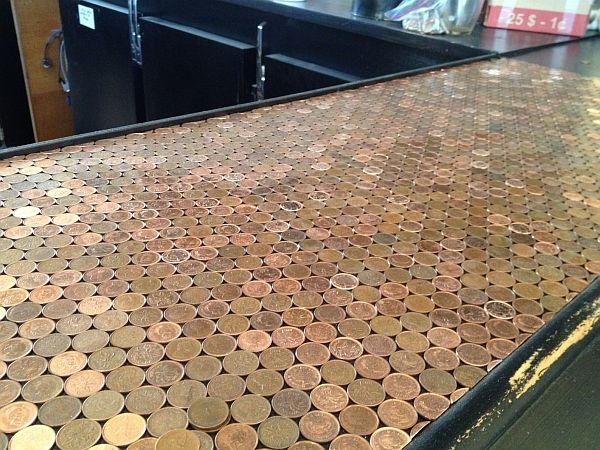
The Canadian government is killing the penny. It costs 1.6 cents to make, so it will no longer be minted after next fall. Canada says that will save the government $11 million.
So it’s time to empty that penny jar.
If it includes any Canadian coppers, there are a couple of options. Cash them in at a Canadian bank, or spend them. Hoarding is not advised. But at one bistro aptly housed in a former bank in Stanstead, Quebec, just across the border from Derby Line, Vermont, hundreds of pennies are getting preserved atop a bar under construction. Damon Cox is supervising the renovation.
"We tried to maintain the bank theme in the decoration and décor," Cox explained, arranging the pennies in neat rows to cover the bar. "So… we went out before they retired the penny and we got a stackload of pennies from the bank, we cashed them and now we are decorating our bar with pennies, so it will be forever instilled here at the bar."
Actually, Canada would rather have the pennies back. So Canadian banks are taking them in exchange for other currency and returning them to the mint to get them out of circulation. As pennies disappear, merchants are supposed to round up or down-so if you buy something priced at 52 cents, it will cost 50 – and if it’s 53 cents, it will now cost 55.
At the bar, called "Sans Frontieres," Cox says that could mean some headaches for the wait staff.
Eventually, he figures merchants will change their prices to eliminate the need for pennies. Meanwhile, he thinks a lot of customers will stop carrying change, and whip out their debit or credit cards instead.
"Or you know, maybe there will be a revolution and everybody will go back on a barter system where we’re actually trading oats and grain and stuff again, too," he says, laughing.
Now-back to the hoarding question. Will the Canadian penny increase in value posthumously? John Martin, owner of Martin’s Coins and Jewelry in Burlington, says "don’t count on it."
"No, I wouldn’t hoard them away," he advises.
But while sorting through change jars, people could keep an eye out for valuable American specimens. For example, hunt for pre-1959 pennies with Lincoln on one side and a sheaf of wheat on the other.
Martin collects something much more rarefied-Vermont coppers, which were minted in Rupert, Vermont in 1785–the first local government in the new nation allowed to literally make money.
"I actually bought one recently for $9000, it was a Vermont copper, and I’ve sold them as high as $30,000," Martin reports.
So will the Canadian penny become as valuable three hundred years from now as the Vermont copper is today? Martin doubts it. Like some U.S lawmakers, he thinks we should follow Canada’s example, and get rid of the overpriced penny.
But it’s got its fans-a group called Americans for Common Cents.